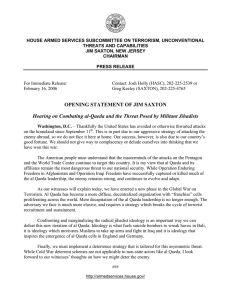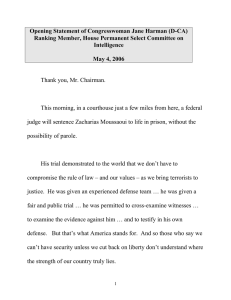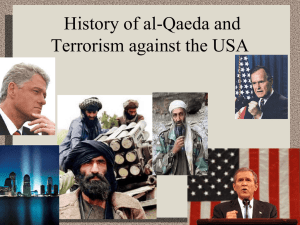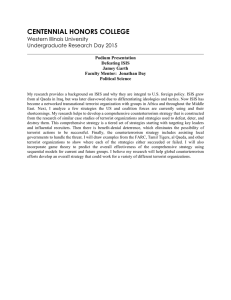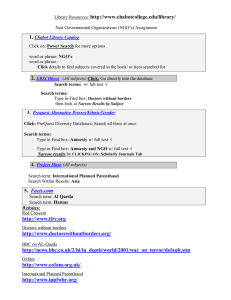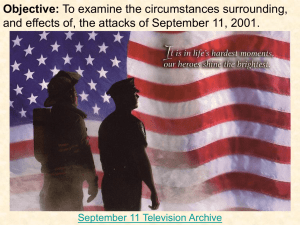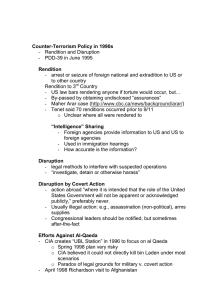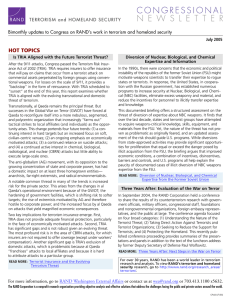The RAND Corporation is a nonprofit institution that helps improve... decisionmaking through research and analysis.
advertisement
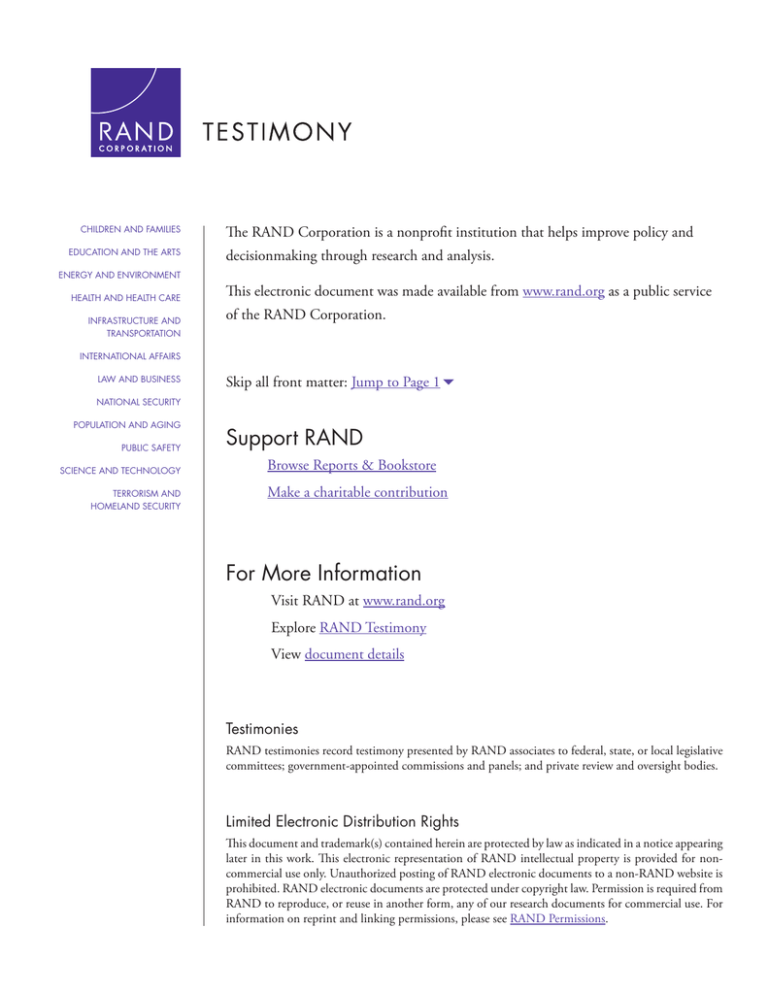
C O R P O R AT I O N CHILDREN AND FAMILIES EDUCATION AND THE ARTS The RAND Corporation is a nonprofit institution that helps improve policy and decisionmaking through research and analysis. ENERGY AND ENVIRONMENT HEALTH AND HEALTH CARE INFRASTRUCTURE AND TRANSPORTATION This electronic document was made available from www.rand.org as a public service of the RAND Corporation. INTERNATIONAL AFFAIRS LAW AND BUSINESS Skip all front matter: Jump to Page 16 NATIONAL SECURITY POPULATION AND AGING PUBLIC SAFETY SCIENCE AND TECHNOLOGY TERRORISM AND HOMELAND SECURITY Support RAND Browse Reports & Bookstore Make a charitable contribution For More Information Visit RAND at www.rand.org Explore RAND Testimony View document details Testimonies RAND testimonies record testimony presented by RAND associates to federal, state, or local legislative committees; government-appointed commissions and panels; and private review and oversight bodies. Limited Electronic Distribution Rights This document and trademark(s) contained herein are protected by law as indicated in a notice appearing later in this work. This electronic representation of RAND intellectual property is provided for noncommercial use only. Unauthorized posting of RAND electronic documents to a non-RAND website is prohibited. RAND electronic documents are protected under copyright law. Permission is required from RAND to reproduce, or reuse in another form, any of our research documents for commercial use. For information on reprint and linking permissions, please see RAND Permissions. TESTIMONY Al Qaeda After Bin Laden Implications for American Strategy BRIAN MICHAEL JENKINS CT-365 June 2011 Testimony presented before the House Armed Services Committee, Subcommittee on Emerging Threats and Capabilities on June 22, 2011 This product is part of the RAND Corporation testimony series. RAND testimonies record testimony presented by RAND associates to federal, state, or local legislative committees; government-appointed commissions and panels; and private review and oversight bodies. The RAND Corporation is a nonprofit research organization providing objective analysis and effective solutions that address the challenges facing the public and private sectors around the world. RAND’s publications do not necessarily reflect the opinions of its research clients and sponsors. is a registered trademark. Published 2011 by the RAND Corporation 1776 Main Street, P.O. Box 2138, Santa Monica, CA 90407-2138 1200 South Hayes Street, Arlington, VA 22202-5050 4570 Fifth Avenue, Suite 600, Pittsburgh, PA 15213-2665 RAND URL: http://www.rand.org To order RAND documents or to obtain additional information, contact Distribution Services: Telephone: (310) 451-7002; Fax: (310) 451-6915; Email: order@rand.org 1 Brian Michael Jenkins The RAND Corporation Al Qaeda After Bin Laden 2 Implications for American Strategy Before the Committee on Armed Services Subcommittee on Emerging Threats and Capabilities United States House of Representatives June 22, 2011 There is a remarkably little consensus among analysts about the threat now posed by al Qaeda. Some view al Qaeda as a spent force, its demise hastened by bin Laden’s death. Others point to al Qaeda’s still active field commands, in particular al Qaeda in the Arabian Peninsula (AQAP); the spread of its ideology, especially on the Internet; its determination to acquire and employ weapons of mass destruction; and the still difficult situations in Afghanistan and Pakistan. Al Qaeda is many things. It is an ideology of violence. It is the inspiration for a global terrorist campaign. It is a tiny army in Afghanistan. It is a loose collection of autonomous field commands and allies in North Africa, the Middle East, and South and Southeast Asia. It is a communications network. Increasingly, it is the conveyer of individual discontents. A thorough assessment would have to examine each component and aspect of its activities. THE FIVE PHASES OF AL QAEDA’S CAMPAIGN We are currently in what might be called the fifth or “post–bin Laden phase” of al Qaeda’s campaign. Phase I – Preparing for war. The first phase began with al Qaeda’s formation in 1988 and includes Saudi Arabia’s rejection of bin Laden’s offer to mobilize an army of mujahadeen instead of American forces to protect the kingdom, along with an angry bin Laden’s subsequent efforts in the early 1990s to rebuild the Afghan network. 1 The opinions and conclusions expressed in this testimony are the author’s alone and should not be interpreted as representing those of RAND or any of the sponsors of its research. This product is part of the RAND Corporation testimony series. RAND testimonies record testimony presented by RAND associates to federal, state, or local legislative committees; government-appointed commissions and panels; and private review and oversight bodies. The RAND Corporation is a nonprofit research organization providing objective analysis and effective solutions that address the challenges facing the public and private sectors around the world. RAND’s publications do not necessarily reflect the opinions of its research clients and sponsors. 2 This testimony is available for free download at http://www.rand.org/pubs/testimonies/CT365/. 1 Phase II – Escalating to 9/11. The second phase began in 1996 with Osama bin Laden’s declaration of war on the United States and al Qaeda’s escalating centrally directed terrorist operations, culminating in the 9/11 attacks. Phase III – A counterproductive terrorist campaign. The third stage began with the American attack on Afghanistan, dispersing al Qaeda’s training camps and putting its leaders on the run. Nevertheless, al Qaeda’s international terrorist campaign continued, with spectacular attacks in Indonesia, Kenya, Tunisia, Morocco, Egypt, Jordan, Turkey, Spain, and the United Kingdom. These attacks, however, provoked crackdowns by local governments, which largely destroyed local jihadist networks. Meanwhile, America’s invasion of Iraq in 2003 opened up another front for al Qaeda, which it exploited with a brutal terrorist campaign aimed primarily at other Muslims in an effort to provoke civil war. But al Qaeda’s wanton violence against civilians and Muslims alienated Muslim communities. In Iraq, even Sunni Muslims turned on al Qaeda—a key turning point in the war. With American reinforcements and a crucial change in counterinsurgency strategy, the Iraqi insurgency began to subside. Phase IV – Individual jihad and do-it-yourself terrorism. The fourth phase, which began in 2007, saw al Qaeda’s recession. During this period, it failed to carry out any significant terrorist attacks outside of Iraq or Afghanistan. Its central command became increasingly dependent on affiliates, allies, and homegrown terrorists to continue its global campaign. Algerian terrorists declared themselves to be part of al Qaeda, while AQAP found new sanctuary in Yemen. AQAP launched several attacks which failed but were nonetheless alarming. Meanwhile, the Taliban, recovered from its defeat in 2001, returned to Afghanistan and expanded its influence throughout the country, compelling the United States to send additional troops. The death of bin Laden—23 years after al Qaeda’s official founding, 15 years after his declaration of war on America—marks the end of this fourth phase. Phase V – Al Qaeda post-bin Laden. The trajectory of al Qaeda cannot be predicted. However, some general observations are possible. 2 AN APPRECIATION OF THE CURRENT SITUATION We have made considerable progress in the past ten years. Al Qaeda’s operational capabilities clearly have been degraded. Its leadership has been decimated, its tiny army scattered. It has not been able to launch a major terrorist operation in the West since 2005. But we have not dented its determination to continue its campaign. The death of bin Laden does not end al Qaeda’s global terrorist campaign. The reported elevation of Ayman al-Zawahiri as al Qaeda’s leader suggests that bin Laden’s focus on attacking the United States will continue after his death. Al Qaeda after bin Laden is likely to be even more decentralized, its threat more diffuse. While he was alive, bin Laden was able to impose a unanimity of focus on his inherently fractious enterprise. No successor will speak with bin Laden’s authority. Al Qaeda could become a collection of autonomous field commands, presided over by a central command, united only in its beliefs. The devastating September 11 attacks were an exceptional event, unprecedented in the annals of terrorism, with far-reaching consequences. Al Qaeda expected its terrorist campaign to inspire jihadist groups worldwide to take up arms. It failed to do so. Instead, al Qaeda turned to indiscriminate slaughter of Muslims, which provoked widespread anger and rejection, although among some young Muslims in the West, brandishing al Qaeda sympathies is an act of defiance—like wearing a Che Guevara T-shirt. Al Qaeda today has far less capability to mount another attack on the scale of 9/11, although caution is in order. Small groups can still be lethal. In 2006, terrorists inspired by al Qaeda’s ideology plotted to bring down airliners flying across the Atlantic. Before that, in 1995, a small group of terrorists, then still outside of al Qaeda’s orbit, plotted to bring down 12 airliners flying across the Pacific. Had the terrorists succeeded in either case, the numbers of casualties would have rivaled those of 9/11. Al Qaeda survives by embedding itself in local insurgencies. It has joined such insurgencies in Afghanistan, Iraq, Algeria, Somalia, making itself part of a larger enterprise into which it can inject its ideology. However, these insurgencies have their own trajectory. Al Qaeda is the beneficiary, not the originator of political violence. Regardless of al Qaeda’s fate, the insurgencies are likely to go on. 3 Decades of internal war and weak national institutions in Afghanistan, Yemen, and Somalia guarantee continued conflict. Pacifying these distant turbulent frontiers in order to preserve public safety at home will be an enduring mission. The revolutions in Tunisia and Egypt and ongoing challenges to Arab autocracies demonstrate the irrelevance of al Qaeda’s ideology and terrorist methods. However, al Qaeda benefits from the chaos and the distraction of government, and if these revolutions are crushed or produce no political change, al Qaeda will find new recruiting space. There are also fears that the ultimate beneficiaries of the upheavals will be well-organized Islamist parties, which, although not violent, hold views nearly as extreme as these of al Qaeda. This would not be good news for al Qaeda, but neither would it be good news for the United States. Al Qaeda’s communications have expanded and improved. The movement’s leaders have always believed that communications are the most important aspect of its activities. The number of its websites has increased. The number of English language jihadist sites has increased. Al Qaeda publishes a slick online magazine that appeals to an audience of young males. Its American-born spokesmen understand and speak to their audience in easily understood terms. Al Qaeda has embraced individual jihadism and do-it-yourself terrorism. Its communicators have argued that organization is not necessary: individual jihad is possible and preferable—it is cheap to wage and harder to thwart. This is a change from al Qaeda’s initial centralized strategy, and it reflects current realities. Do-It-yourself terrorism goes a step further, accepting that even failed terrorist attempts cause alarm and force governments to devote disproportionate resources to security. The objective is to bankrupt America’s already weakened economy. Ultimately, al Qaeda hopes to turn this audience of online jihadists into the real thing. Thus far, it hasn’t worked. Al Qaeda’s virtual army remains virtual. Al Qaeda’s exhortations to join its violent jihad have thus far yielded meager results among American Muslims. Between 9/11 and the end of 2010, 176 persons were identified as providing material support to jihadist terrorist groups, attempting to join terrorist fronts abroad, or plotting to carry out terrorist attacks in the United States. Authorities have found no terrorist undergrounds, no armies of sleeper cells. Many of those identified were Somalis, a special case that may be explained more by intense nationalism following Ethiopia’s invasion of Somalia than by jihadist ideology. Overall, converts to Islam account for a disproportionate percentage of the homegrown terrorists, suggesting that radicalization and recruitment to terrorism is an individual rather than a community phenomenon. 4 Few American jihadists have been self-starters. Of the 32 plots to carry out terrorist attacks in the United States, only 10 had anything resembling an operational plan. Six of these were FBI stings. Provided with the means, these self-proclaimed jihadists were demonstrably willing to kill. On their own, only three plots got as far as carrying out an attack; authorities intercepted the fourth. Only two attacks, both carried out by lone gunmen, succeeded. This level of terrorist violence contrasts with the level in the 1970s, when there were 50 to 60 terrorist bombings a year in the United States. IMPLICATIONS FOR COUNTERTERRORIST STRATEGY This is an appropriate time for a review. Ten years of counterterrorism and counterinsurgency offer historical perspective and hard-earned knowledge of the threat we confront as a nation. As al Qaeda has evolved, so must American strategy. This cannot be a linear, sequential strategy. Instead, we should talk about strategic principles. We must accept great uncertainty about what may happen in the next decade—there will be surprises. If on this date ten years ago, I, with far more prescience than I can claim, had accurately predicted the events of the following decade—the 9/11 attacks; the American invasions of Afghanistan and Iraq; America’s longest war, with 100,000 American troops still in Afghanistan and another 40,000 still in Iraq; a wave of revolutions sweeping across North Africa and the Middle East; NATO aircraft bombing Libya—you would have dismissed me as an imaginative novelist. Al Qaeda and its affiliates remain the primary target of America’s counterterrorist campaign; efforts to destroy it must be relentless. Although weakened, the jihadist movement still poses a threat. Historically, al Qaeda has shown itself to be resilient, organizationally flexible, and opportunistic. It remains determined to bring down the United States. Left unmolested, it will find new sanctuaries from which to pursue its campaign. Its complete destruction is also a matter of justice that will serve as an object lesson for other groups that may contemplate attacking America. International cooperation must be preserved. War-weariness, economic constraints, and the death of bin Laden may erode the unprecedented worldwide cooperation among intelligence services and law enforcement organizations that has succeeded in reducing al Qaeda’s capability to mount large-scale attacks. It is crucial that this cooperation be preserved. 5 How things turn out in Afghanistan remains critical to the future trajectory of the conflict. Although some argue that America need not wage endless war in Afghanistan in order to destroy al Qaeda, it is hard to see how civil war in the country or a Taliban takeover would serve U.S. objectives. Al Qaeda would almost certainly find a less hostile environment there. Creating a national army and police force in Afghanistan able to effectively secure the country will take longer than the United States is likely to be willing to sustain current troop levels. A drawdown of American forces is necessary, but arbitrary timetables that dictate the pace of withdrawal could encourage the Taliban to wait us out while discouraging our Afghan allies. Abandonment of Afghanistan would be dangerous. Guaranteeing a stable unified democratic Afghanistan, free of political violence is not achievable. We should examine ways we can reconfigure our effort. The development of local and tribal Afghan defense forces can be accelerated to help fill the gap. These are within Afghan tradition, but require supervision to ensure their effectiveness and prevent abuses. An overall peace settlement with the Taliban seems unrealistic. Instead, talks can encourage local accommodations and reconciliation. Talking does not end the fighting. It is a component of the contest. Large commitments of American ground forces should be avoided. The American armed forces have gained tremendous experience in combating insurgencies, but Americans have also learned that counterinsurgency and nation-building can be costly and require open-ended commitments. The challenge is how to deprive al Qaeda and its allies of safe havens without the United States having to fix failed states. Counterterrorism has framed much of U.S. foreign policy for nearly a decade. Whatever new governments emerge in the Middle East, the issue of terrorism will not likely be at the top of their agenda. Counterterrorism cannot be the single note of America’s diplomacy. We cannot seek or invent an artificial end to the war on terrorism. This is not a finite wartime effort followed by demobilization. We may be chasing al Qaeda for decades. While rejecting the idea of permanent warfare, we must accept the notion of eternal vigilance. What we do at home and abroad must be sustainable. It is premature to dismantle the structure we have constructed for security, but the government should be very cautious about adding new security measures. Extraordinary security measures almost invariably become permanent features of the landscape. Efforts should focus on developing less burdensome and more efficient ways to maintain current security levels. We should also move toward risk-based security rather than pretending that we can prevent all attacks. 6 Public expectations of security must be realistic. The nine years and nine months since 9/11 represent the longest passage of time without a major terrorist attack on an American target abroad or at home since the late 1960s with exception of the tragic shooting at Fort Hood. Americans have come to expect that authorities will prevent all terrorist attacks and react with outrage and anger when even a failed attempt occurs. This is not realistic. Even unsuccessful al Qaeda attacks could succeed in undermining our economy if we respond to each with selfinjurious security investments and protocols. The threat of homegrown terrorism is real but should not be exaggerated. The paucity of jihadist recruits suggests that America remains a tolerant nation where immigrants successfully assimilate into the everyday life of our communities and the nation as a whole. America’s Muslims are not America’s enemies. Domestic intelligence collection is essential, especially as al Qaeda places more emphasis on inspiring local volunteers to take action. Local police are frontline collectors. The Muslim community is not being picked on. This is not indiscriminate surveillance simply because people are Muslims. The nature of the threat determines the social geography of the collection effort. In response to criminal and terrorist threats in the past, immigrant diasporas and domestic ethnic groups have been the targets of intelligence efforts. Ku Klux Klan violence in the 1960s focused intelligence efforts on certain southern white communities. Anti-Mafia investigations focused on the Italian community. No apologies are necessary. At the same time, community policing to build trust and open lines of communication are critical to reducing radicalization and preventing terrorist attacks. In sum, we have greatly reduced al Qaeda’s capacity for large-scale attacks, but the terrorist campaign led by al Qaeda may go on for many years. It is fair to call it a war, without implying that, like America’s past wars, it must have a finite ending. But it is time for a fundamental and thoughtful review of our effort. America’s current troop commitments abroad cannot be sustained, nor can we eliminate every vulnerability at home. We have gone big. We need to go long. 7
